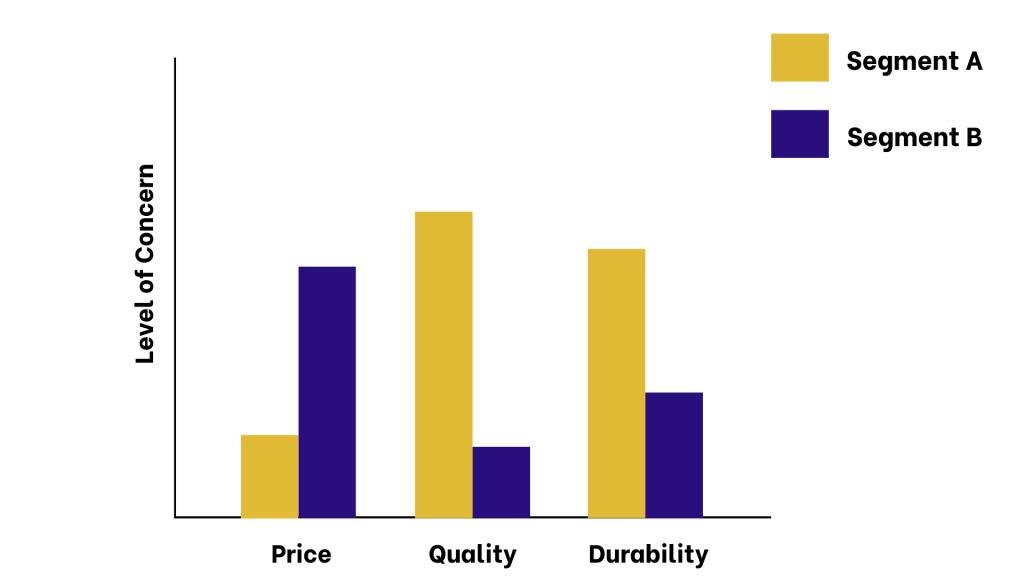Every day new businesses are springing up and brands are expanding, but one mistake that has remained common among businesses especially startups and SMEs is the mistake of brand positioning. A lot of businesses have built their brand over the years without a proper understanding of their market segments, who their true customers are and this has affected their level of value delivery and profit maximization over time. A clear example is seen in this graph below;

The graph above shows the behavior of two different market segments to a particular product you sell – say clothes. Segment A, represented in gold is a group of individuals who do not care about the price of a product, they are more concerned about the quality and durability of the products they purchase, in this case, your clothes.
While Segment B, represented in blue comprises very price-sensitive individuals, they care less about the quality of the product they buy, likewise their durability.
Without a proper understanding of the behaviors and preferences of these two different segments, it will be very difficult to position your brand to address any of the segments effectively, and trying to address both segments using the same product or service might just end up being a big fail, as the price might be too high for Segment B and the quality or durability too poor for Segment A, therefore no conversion in either of the segments.
How to Position Your Brand to Address Your Ideal Customer in Different Market Segments
There are various methods and techniques such as your brand message, business model, marketing techniques, etc which you can use to position your brand to reach your ideal target audience, but one very effective method of brand positioning is through market segmentation. A great tool in achieving this is the STP framework.

SEGMENTATION
This is the first step in the framework and in my opinion the most important. It is the process where you divide your market into distinct subsets, where any of the subsets may be selected as a target audience for your business to serve.
There are four major methods with which you can segment your market. They are;
- Demographic Segmentation
- Psychographic Segmentation
- Behavioral Segmentation
- Geographic Segmentation
Demographic Segmentation; this is a very popular and commonly used method of segmentation; it offers a superficial breakdown of your customer personas in the market. For a B2C business, it involves segmentation on information such as gender, age, education, income rate, employment, and even birth and death rates. Whereas a B2B business involves segmentation based on factors like company size, industry, job function, etc.
One very important segmentation type under demography is the cohort analysis. The cohort analysis refers to segmentation by the different generations; generation X, Y, Z.
Every generation has its unique characteristics of how they interact with products and services. For example, Gen Y also known as millennials, are a generation born with the internet, they are very social media savvy, they buy almost anything online, they seldomly read the papers, and they love brands with products and services that relate to them personally (customer-centered).
A piece of information like this can help you position your brand to address effectively the needs of this market segment using the right marketing channel, the right brand message, and using the right distribution network.
Psychographic Segmentation; this type of segmentation categorizes audiences and customers by factors that relate to their personalities and characteristics. For example, their lifestyle, interests, priorities, motivations, opinions, values, etc. Unlike demographic, psychographic segmentation is slightly more difficult to identify, and it requires some level of research to uncover to truly understand the customer.
Behavioral Segmentation; this type of segmentation focuses more on how the customer acts. It looks at their purchasing habits – how often do they buy, their spending habits – how much do they tend to spend while buying, brand interactions – how loyal are they to a particular brand, etc.
These activities may relate to how they interact with your brand or to other activities that happen away from your brand.
Geographic Segmentation; this type of segmentation involves the study of your customer based on their physical location. In this segmentation, consumers are grouped based on similar locations they share or the neighborhood they live in. For example, customers in Lekki Lagos Nigeria might have the same behavioral activities as customers living in Runda Nairobi Kenya, they may share similar preferences and even have similar behavioral patterns.
TARGETING
The next step in the STP framework is targeting. Having segmented your market using different market segmentation techniques, it is time to target the particular segment which you will be servicing and to do this, you have to consider the following factors;
- The attractiveness of the market; includes an evaluation of the segment size, growth rate, the stability of the segment, etc.
- Brand capability; this includes questions like, what’s the capacity of my brand to serve this segment? Is this an easy segment to penetrate? Etc.
- The competitive landscape; here you have to consider the major players in that market, their strengths, can you be able to compete against them, do you have a competitive advantage, etc.
After careful consideration of the different subsets of segments using these factors, your goal is to select the most attractive segment, and where you can deliver having a strong competitive advantage.
POSITIONING
This is the final stage of the STP framework, and it is the stage where you reach out to your selected target audience using all the insights you have inferred from the other steps of the framework.
The best way to position your brand to reach your target audience is through the Marketing Mix (4P’s of marketing). The marketing mix which is a very important marketing concept emphasizes the type of Product you have developed, the Price of your product, your channels of Promotion, and your Place of promotion.
The whole essence of market segmentation and brand positioning is to clearly know your market segments and target customers, understand their needs and be able to provide maximum value for them while maximizing profits for your brand.


